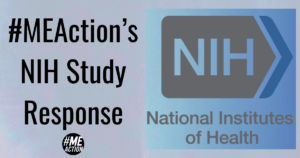Editor’s note: This is a clarification on the NIH’s earlier, accidental release of the intramural study protocol, which listed the Reeves definition as the sole definition of the new study. Robert and Courtney’s summary of their conversation has been confirmed by multiple sources within the patient community, including #MEAction.
Robert and I had a well-timed chance to discuss with NINDS some questions about the protocol that was posted this weekend for the NIH Clinical Center study. There will be additional information posted on a website for patients and the community which may take a week to be live, they said.
We asked questions about the criteria for enrollment, reference to Reeves criteria in the protocol, role of ME/CFS experts and the choice of control groups. According to the principal investigator of the study:
- Enrollees will meet all definitions for ME/CFS, including Canadian Consensus Criteria, IOM, Fukuda and Reeves, in addition to post-infectious onset.
- Post-exertional malaise (PEM) is a criteria, and will be specifically studied with extensive testing before and after exercise challenge.
- The SF-36 criteria to measure functional impairment stated in the protocol online is inverted mistakenly. “Greater than” is meant to be “less than” in the SF-36 measures.
- Dr. Ian Lipkin of Columbia University’s Center for Infection and Immunity has been advising the investigators on the study design and protocol.
- Expert clinicians will be used in patient selection.
- Control groups: Asymptomatic Lyme was chosen to contrast post-infectious ME/CFS patients to patients who recovered from an infection. Functional Movement Disorder was chosen to contrast post-infectious ME/CFS patients with a very well-studied group of patients with clear psychological illness with neurological presentation.
- They seek to have 40 PI-ME/CFS patients, and they will study them longitudinally, hoping to learn how and whether the disease changes over time.
- Testing will be extensive.
We are very excited to know that the NIH intramural study is moving forward, and that it will deeply study patients with infectious onset against a battery of biological tests. We are reassured by these answers, and eager to have this kind of data to move our disease toward discovery.
— Courtney and Robert Miller






20 thoughts on “Positive Answers to Initial Questions re NIH Clinical Center Protocol”
Yes on PEM? I know I am happy! Post Infectious – ’bout time!
Great news. A shame its not a few hundred pwME, being studied but a move in the right direction. Cancer research is getting another billion dollars…how much is ME, getting?
NIH has once again disappointed patients. The way this study was made public, with all its self-evident flaws, reveals how amateurish the team is.
With respect to the above authors, I’ll believe these points of clarification when the NIH releases its own public statement.
Until then, they have proven themselves untrustworthy. A crucial element for research with patient participants.
They must be embarrassed as their research peers see the sh*t show.
Sigh.
Thank you for your excellent statement regarding the NIH “study.” Am too ill to sit up, never mind exercise. (I am entering the third decade of this hell.) After extensive research over the years and having had the good luck to have known a couple of very insightful scientists, I conclude that nothing useful is going to come out of the US government. They care not for the >million civilians plus uncounted veterans who deal with a living death.
Some of the truly interesting work is highlighted in the newly released film, “Forgotten Plague.” Significant additional funding to the extraordinary scientists in this film may finally make a difference. (If unfamiliar, forgottenplague.com. Totally worthwhile.
Thank you Robert and Courtney Miller. Unfortunately, I remain confused about the definition to be used when admitting a patient. Are you saying that EACH enrollee must meet the CCC, SEID, Fukuda, AND Empirical (Reeve’s) definitions? (In that case, isn’t there a bit of redundancy?) Perhaps the NIH means that EACH enrollee must meet at least ONE of the following definitions: CCC, SEID, Fukuda, OR Empirical (Reeve’s)? In this case, it would indicate that our own expert clinicians are using a broad base of definitions in their practices if that is where the enrolles are to be chosen.
I absolutely HATE the new term of SEIDS. Doctors are recognizing and trying their best to treat our disease by the name of ME/CFS. Changing what has come to be a recognized term is the most insane part of all.
If we as patients are confused with the new name, I shudder to think about how the medical establishment is going to now look at the disease as, “Oh. Just another exhausted patient. I’m exhausted treating patients. This name change just includes exhausted people who the world is full of. ” that’s my nightmare of what the new term may be looked upon as being. What then is the FDA going to do about approval of medications for the newly named disease? Will they treat the new name as much as the former name and not recognize the usage of drugs being used for ME/CFS the same way as SEIDS?
Hi Polly, we’ve been told each patient will have to meet all the criteria, plus have infectious onset. That means the tightest criteria will prevail. NIH will be clarifying these issues in a website expected to be available within a week.
thank you, Courtney and Robert Miller 🙂
marvellous that PI-ME/CFS patients must meet ALL of those criteria (including PEM).
now that you’ve clarified their protocol, it gives us hope, instead of further despair.
Beth asked me to share my concerns here so you could submit them to the appropriate NIH members, so here it goes:
I’m flabbergasted by their “comparison” group using “asymptomatic Lyme” patients…i.e. people assumed to be recovered just because they don’t have fatigue? I didn’t get fatigue from Lyme disease until a full year after the tick bite, many people go even longer.
I’ve read their clarification (posted here
http://meaction.net/2016/02/09/positive-answers-to-initial-questions-re-nih-clinical-center-protocol
) which further states:
“Asymptomatic Lyme was chosen to contrast post-infectious ME/CFS patients to patients who recovered from an infection.”
This is terrible for many reasons.
I’m very concerned that they do not understand how chronic Lyme disease works…hugely in part because, if they support the IDSA (infectious disease society of america) and CDC, they probably think it doesn’t even exist, choosing to ignore the multiple studies that have come out in recent years proving that Lyme disease can *and does* persist after antibiotic treatment, and that the standard 2-4 weeks of Doxycycline does not always cure it. A study published in 2011 actually showed (what Lyme Literate physicians have known for years) that all most antibiotics did, in fact, was (in vitro) cause the bacteria to change forms, until the coast was clear, at which point they emerged, *alive.* Do they understand this? The one-type-of-antibiotic approach actually CAUSED the bacteria to go into hiding, giving only the *illusion* of being asymptomatic! (
https://www.dovepress.com/evaluation-of-in-vitro-antibiotic-susceptibility-of-different-morpholo-peer-reviewed-article-IDR
) This also happens in vivo in real people, but I don’t have a study to back it up (though one may exist–trying to save spoons by giving what I have available on-hand).
There ***absolutely, without a doubt*** needs to be a physician from the ILADS (international lyme and associated diseases society) on this team, or this study is doomed to fail, from ignorance of the facts at hand. It’s not their fault if they don’t already know, but if someone brings this to their attention–like us–and they do not listen, then it is their responsibility. I want to make it their responsibility, to use this information.
There’s also that they apparently don’t plan to test for Lyme disease, either in the “ME/CFS” group OR the Lyme comparison group?
It’s crucial to test the “ME/CFS” group, because misdiagnosis is rampant in our community. Plus, just because you have one disease doesn’t mean you can’t get another. Regardless of when/where it came from, there can’t be any Lyme disease in the ME/CFS group or the results will be biased. I think I’ve already pointed out that the “asymptomatic lyme” group may still actually be harboring the bacteria, also corrupting the validity of its control group.
And the testing? It can be and often is, terrible, so if they did actually choose to do it, it’d need to be with multiple methods.
The ELISA is awful. Here’s just ONE studied case of people who were immunocompromised (like me) who all tested negative in ELISA (like me) yet all tested positive via Western Blot (also like me):
http://www.ncbi.nlm.nih.gov/pubmed/20437826
This isn’t even mentioning the fact that after you get Lyme disease, it can suppress your immune system, causing negatives even in *immunocompetent* people! (Here’s a list of links to many studies, entitled “lyme disease leads to immunosuppression”
https://www.facebook.com/notes/jerry-seidel/lyme-disease-leads-to-immunosuppression/10207344803208455
)
Meanwhile, the CDC literally states on its website (
http://www.cdc.gov/lyme/diagnosistesting/labtest/twostep/eia/index.html
):
“EIA [ELISA] tests are designed to be very ‘sensitive’, meaning that when they are used properly, almost everyone with Lyme disease will test positive.”
Yeah, that didn’t work out, did it. They also promote a “two tier” testing which says, you should *only* get a Western Blot *if your ELISA comes back positive*…which means people who fail the first one (like I did, like so many do) won’t even get the additional western blot, etc!
This study here, all the way back from 2005, found that the only way to diagnose it 100% was by using culture (which takes 3.5 weeks), skin PCR, AND serologic tests. http://www.ncbi.nlm.nih.gov/pmc/articles/PMC1248466/
Meanwhile the CDC recommends AGAINST using culture to detect Lyme disease…the same culture the researchers above found was one of the main components of confirming it.
Similarly, the ILADS frequently quotes the statistic “of patients with acute CULTURE-PROVEN Lyme disease, 20–30% remain seronegative on serial western blot sampling” (emphasis added). (
http://www.ilads.org/lyme/about-lyme.php
)
So not only do the subjects in both groups need to be tested to reflect a consistent, up-to-date level of accuracy, but they need to be tested in a way that have a high specificity…which most doctors know nothing about. If these NIH researchers actually do get someone to help them with Lyme testing, it cannot be someone who agrees with these CDC recommendations, which obviously don’t work. Hence the *pertinence* of recruiting an ILADS physician!
Why do they need to contrast ME/CFS people who are asymptomatic of Lyme Disease period? ME/CFS is a separate disease, unless the NIH thinks that the ME/CFS patients need to be tested for Lyme Disease? Do we need tested for Lyme Disease? What the heck is going on here?
It is common in scientific research to compare patients with the disease you are studying to healthy controls, and to patients with a different illness. Dr. Nath’s presentation to CDC Grand Rounds says the study will compare 40 post-infectious ME/CFS patients compared to 20 healthy controls, 20 who contracted Lyme disease and do not have a chronic illness, and 20 who have Functional Movement Disorder. Dr. Nath described to Bob and me the purpose for these different control groups as follows: Asymptomatic Lyme patients were infected with Lyme and their immune systems reset to a normal state, which contrasts to the immunological dysfunction in ME/CFS. Functional Movement Disorder is a very well studied psychological disorder where they can show on fnMRIs where the signaling stops in the brain that stops movement. They will contrast ME/CFS to that disorder.
You can view Dr. Nath’s presentation at minute 42:40 at this link: https://www.youtube.com/watch?v=0SnJy5AOSd8&utm_content=bufferbeda4&utm_medium=social&utm_source=twitter.com&utm_campaign=buffer
Courtney Miller
To: [email protected]
Re: Lyme disease changing forms in vivo:
http://www.akademiai.com/doi/abs/10.1556/1886.2015.00049
Feb 9, 2016
“Lyme borreliosis, caused by the spirochete Borrelia burgdorferi sensu lato, has grown into a major public health problem. We recently identified a novel morphological form of B. burgdorferi, called biofilm, a structure that is well known to be highly resistant to antibiotics. … Our morphological and histological analyses showed that significant amounts of Borrelia-positive spirochetes and aggregates exist in the BL tissues. Analyzing structures positive for Borrelia showed that aggregates, but not spirochetes, expressed biofilm markers such as protective layers of different mucopolysaccharides, especially alginate. Atomic force microscopy revealed additional hallmark biofilm features of the Borrelia/alginate-positive aggregates such as inside channels and surface protrusions. In summary, this is the first study that demonstrates the presence of Borrelia biofilm in human infected skin tissues.“
Read http://www.me-ireland.com/nih-project.htm
Thank you very much for pressing for answers regarding the Reeves’ protocol. I would like to comment on the overall confusion that now reigns. Did the NIH intend their study to just use the Reeves’ criteria? And then, did they see the flash back coming down the pike at them, and hastily decide to add the other criteria to stem the tide? Whatever their intentions are, I think it very prudent given thirty years of malfeasance, that the ME community have advocate observers closely involved in this study.
I don’t want to defend NIH as I think there are still a lot of open questions, but I do believe them when they say that they were planning on only taking patients who met multiple criteria. They had been in touch with expert clinicians about referring patients before the protocol got published, so I don’t think they intended to get applicants off the street. I don’t know why they didn’t mention the other criteria in the draft protocol, however. And I completely agree that it is “very prudent given thirty years of malfeasance, that the ME community have advocate observers closely involved in this study.”
Hi Cindy, good question. The overriding criteria for the NIH Clinical Center study has always been post-infectious onset. When Dr. Collins, Director of NIH, announced a renewed research program for ME/CFS in October, he announced an intramural study that would focus on patients who developed ME/CFS following infection. The NIH press release dated October 29, 2015 said: “NIH will design a clinical study in the NIH Clinical Center with plans to enroll individuals who developed fatigue following a rapid onset of symptoms suggestive of an acute infection.” The protocol which was posted last weekend did require patients who would be enrolled to document ME/CFS following an infection. That requirement makes this study similar to Dr. Lipkin’s studies, and as we learned, Dr. Lipkin is advising on this study. Post infectious onset narrows substantially any criteria used, and the Reeves criteria were never going to be the only criteria for enrollment. It is good confirmation that the Canadian Consensus Criteria will be used, and that this study will closely resemble Dr. Lipkin’s investigations, with the potential to study so many more data points. I hope that helps answer your question.
I thought the medical community were using the ICC CRITERIA, dropping Fukada. And do you have an ICD CODE for SEID? Why not drop the CFS since it is quite different from M.E.?
Will Staci Stevens and/or any of the other experts at The Workwell Foundation be consulted for their expertise in conducting the CPET?
Will the ME/CFS neuropsychologist expert Sheila Bastien, Ph.D. be consulted with regard to any neuropsychological/neurocognitive testing?
How long after the CPET will patients be monitored?
Exclusion criteria for all participants includes, “Current immunologic disorder (e.g. Type 1 diabetes, rheumatoid arthritis)”, yet the IOM MECFS clinicians guide lists “Immune impairment” on page 13: https://iom.nationalacademies.org/~/media/Files/Report%20Files/2015/MECFS/MECFScliniciansguide.pdf. This seems inconsistent and a significant contradiction. Don’t many/most/all M.E. patients have some form of an immunologic disorder – at the very least, autoimmune thyroid disease? How is this exclusion scientifically justified?
Additional exclusion criteria for participants with CFS: “Underlying illness that may cause fatigue such as thyroid dysfunction…” – see observations listed just above.
Why would NIH even publicly mention Reeves? Did they not understand how Reeves is viewed by the M.E. community and other M.E. expert physicians and researchers?
“Enrollees will meet all definitions for ME/CFS, including Canadian Consensus Criteria, IOM, Fukuda and Reeves, in addition to post-infectious onset.” In all honesty, their list reads like the contents of the kitchen sink. Don’t M.E. patients really want – or require – more focused criteria, say the ICCC? What is being said by listing all of these different criteria? Not clear at all.
I was shocked by the omissions in the so-called “Diagnostic Algorithm” on page 14 of the IOM’s “Beyond ME/CFS, Redefining an Illness: Report Guide for Clinicians”. There was no list of blood tests to perform such as those administered at Stanford’s CFS Clinic or the Open Medicine Clinic in Mountain View. How does NIH expect M.E. patients and their caregivers to respect use of the IOM report when it lacked any real specificity on so many critical topics?
Just a few questions…
More questions…
Has the NIH offered a compelling explanation as to why their initial study does not focus on – or even include (!) – severely ill M.E. patients – instead of being limited to no more than moderately ill M.E. patients?
How many of each type of participant (PI-ME patient; healthy volunteer; Documented Lyme Infection Asymptomatic; functional movement disorders) will be included in the study?
Why does the study exclude PI-M.E. patients for whom fatigue onset occurred more than 5 years prior to study enrollment??
And lastly… will the NIH reach out to Dr. Ron Davis for his input? Why wouldn’t they reach out to such a brilliant and dedicated scientist with who has so much to offer this study?
Comments are closed.